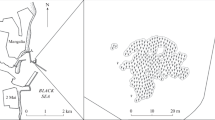Abstract
Eudendrium glomeratum Picard, in the Ligurian Sea, is one of the major components of hard-bottom sessile zoobenthos in the cold season. It settles mainly between 10 and 40 m depth, forming a seasonal facies. The presence of E. glomeratum has been evaluated by measuring in situ the height of the colonies present within a standard surface of 1 m2. Observations were carried out every other week for a whole year. The height of the colonies was correlated with their biomass (wet weight) and trophic functionality (number of polyps). The quantitative evaluation of the population shows that the situation is stable, with almost identical values at the extremes of the observed yearly time series. The species is present from October to April–May, and it is absent in the summer. The formation and disappearance of the E. glomeratum population are sudden. The colonies are sexually mature from their appearance in October to December–January. Different categories of colonies are recognizable; and are essentially referable to two groups: (1) colonies deriving from regeneration of colonies present in the previous year (45%); (2) colonies deriving from planula settlement (43%). A third group (12%) is of uncertain origin and may belong to either of the abovementioned categories. Mortality is 60% in the first group, and 82% in the second one. By “dead colonies” is meant those which do not reappear after a yearly cycle.
Similar content being viewed by others
Literature cited
Boero, F.: Osservazioni ecologiche sugli idroidi del sistema fitale del promontorio di Portofino (Genova, Italia). Nat. sicil. S. 4, 6 (Suppl.) 3, 541–545 (1982)
Boero, F.: The ecology of marine hydroids and effects of environmental factors: a review. P.S.Z.N.I: Mar. Ecol. 5, 93–118 (1984)
Boero, F. and P. Cornelius: First record of the hydroid Eudendrium glomeratum in British and Irish waters. Ir. Nat. J. (In press)
Boero, F. and E. Fresi: Zonation and evolution of a rocky bottom hydroid community. P.S.Z.N.I: Mar. Ecol. (In press)
Crowell, S.: Differential responses of growth zones to nutritive level, age and temperature in the colonial hydroid Campanularia. J. exp. Zool. 134, 63–90 (1957)
Della Croce, N., M. Fabiano and T. Zunini Sertorio: Biomassa planctonica, sali nutritivi, parametri idrologici. Catt. Idrob. Pescic. Univ. Genova, Rapp. Tecn. 11, 1–14 (1980)
Fadlallah, J.: Population dynamics and life history of a solitary coral, Balanophyllia elegans, from Central California. Oecologia 58, 200–207 (1983)
Fey, A.: Peuplements sessiles de l'archipel de Glénan. 1 — Inventaire: hydraires. Vie Milieu Ser. B 20, 387–414 (1969)
Hughes, R.: Aspects of the biology and life-history of Nemertesia antennina (L.) (Hydrozoa: Plumulariidae). J. mar. biol. Ass. U.K. 57, 641–657 (1977)
Hughes, R.: The life history of Tubularia indivisa (Hydrozoa: Tubulariidae) with observations on the status of T. ceratogyne. J. mar. biol. Ass. U.K. 63, 467–479 (1983)
Motz-Kossowska, S.: Contribution à la connaissance des hydraires de la Méditerranée occidentale. I. Hydraires Gymnoblastiques. Arch. Zool. exp. gén. 4, 40–97 (1905)
Picard, J.: Note sur les hydraires littoraux de Banyuls-sur-mer. Vie Milieu Ser. B 2, 338–349 (1951)
Schlichter, D.: Epidermal nutrition of the alcyonarian Heteroxenia fusescens (Ehrb.): absorption of dissolved organic material and loss of endogenous photosynthases. Oecologia 53, 40–49 (1982)
Sebens, K.: Population dynamics and habitat suitability of the intertidal sea anemones Anthopleura elegantissima and A. xanthogrammica. Ecol. Monogr. (In press)
Svane, I.: Ascidian reproductive patterns related to long-term population dynamics. Sarsia 68, 249–255 (1983)
Svoboda, A.: Underwater observations on the life cycle of Corymorpha nutans. Helgoländer wiss. Meeresunters. 24, 145–150 (1973)
Teissier, G.: Cnidaires—Cténaires. Inventaire de la faune marine de Roscoff. Roscoff 1965
Turpaeva, E., M. Gal'perin and A. Simkina: Food availability and energy flux in the mature colonies of the hydroid polyp Perigonimus megas (Kinne). Okeanologiya 17, 1090–1101 (in Russian) (1977)
Werner, B.: Effect of some environmental factors in differentiation and determination in marine Hydrozoa, with a note on their evolutionary significance. Ann. N.Y. Acad. Sci. 105, 461–488 (1963)
Author information
Authors and Affiliations
Additional information
Communicated by B. Battaglia, Padova
Rights and permissions
About this article
Cite this article
Boero, F., Balduzzi, A., Bavestrello, G. et al. Population dynamics of Eudendrium glomeratum (Cnidaria: Anthomedusae) on the Portofino Promontory (Ligurian Sea). Marine Biology 92, 81–85 (1986). https://doi.org/10.1007/BF00392749
Accepted:
Issue Date:
DOI: https://doi.org/10.1007/BF00392749




